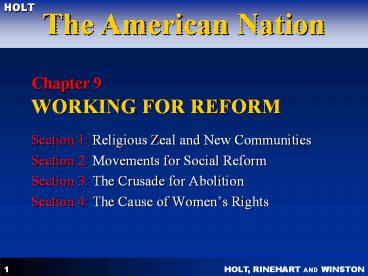Chapter%209%20WORKING%20FOR%20REFORM PowerPoint PPT Presentation
Title: Chapter%209%20WORKING%20FOR%20REFORM
1
Chapter 9 WORKING FOR REFORM
- Section 1 Religious Zeal and New Communities
- Section 2 Movements for Social Reform
- Section 3 The Crusade for Abolition
- Section 4 The Cause of Womens Rights
2
Objectives
Section 1 Religious Zeal and New Communities
- Who participated in the Second Great Awakening?
- What were the main characteristics of the Shakers
and Mormons? - What ideas did transcendentalism promote?
3
Participants in the Second Great Awakening
Section 1 Religious Zeal and New Communities
- people living on the frontier
- people living in the cities of the Northeast
- African Americans
- middle-class women
4
Shaker beliefs
Section 1 Religious Zeal and New Communities
- separate yet relatively equal roles for men and
women no marriage - property jointly owned by the community
- Christ would soon return to rule Earth
- Utopian community
5
Mormon beliefs
Section 1 Religious Zeal and New Communities
- Utopian community
- plural marriage for men
- Divine assistance had given new religious
teachings.
6
Transcendentalist ideas
Section 1 Religious Zeal and New Communities
- People could attain perfection through knowledge
about God, the self, and the universe. - importance of the individual
- natural simplicity
- spiritual renewal
7
Objectives
Section 2 Movements for Social Reform
- What motivated temperance reformers?
- Why did some women believe it was important to
become involved in reform movements? - How did educational opportunities change in the
early 1800s? - How and why did reformers work to improve prisons
and other institutions?
8
Temperance reformers
Section 2 Movements for Social Reform
- wanted to reduce criminal behavior, family
violence, and poverty - desired a more disciplined workforce
- wanted to preserve the family
9
Women and reform
Section 2 Movements for Social Reform
- Many women believed that they had a duty to
become involved in reform since they were
expected to instill values of good citizenship in
their children and serve as the moral voice in
their household.
10
Education in the early 1800s
Section 2 Movements for Social Reform
- expansion of public education
- opening of first public high school
- expansion of opportunities for women and African
Americans to receive a college education
11
Jails and prisons
Section 2 Movements for Social Reform
- Reformers created the penitentiary system, built
more prisons, and established reform schools to
deal with the imprisonment of juveniles with
adult offenders.
12
Poorhouses
Section 2 Movements for Social Reform
- Reformers established a network of poorhouses,
where the able-bodied poor would be required to
work and where poor children could be educated.
13
Mental hospitals
Section 2 Movements for Social Reform
- Rehabilitation hospitals were established to get
mentally ill people out of jails and poorhouses.
14
Objectives
Section 3 The Crusade for Abolition
- How did African Americans change the focus of
antislavery efforts? - What sparked the call for immediate abolition?
- How did the Anti-Slavery Society spread its
message? - What obstacles did the abolitionist movement face?
15
Focus of antislavery efforts
Section 3 The Crusade for Abolition
- African Americans changed the focus of
antislavery efforts through their opposition to
plans for colonization.
16
The call for immediate abolition
Section 3 The Crusade for Abolition
- Impatience with the abolition movements lack of
progress led some leaders such as David Walker
and William Lloyd Garrison to call for immediate
abolition.
17
Obstacles to the abolition movement
Section 3 The Crusade for Abolition
- violence
- fear and prejudice against free African Americans
- internal conflict
18
Objectives
Section 4 The Cause of Womens Rights
- How did the womens rights movement grow out of
the abolitionist movement, and what opposition
did it face? - What did early womens rights activists demand?
- What did the early womens rights movement
achieve, and what issues remained unresolved?
19
Womens rights movement grew out of abolition
movement
Section 4 The Cause of Womens Rights
- The womens rights movement grew out of the
abolition movement because many women who worked
for abolition began comparing their situation to
that of the slaves.
20
Opposition to womens rights movement
Section 4 The Cause of Womens Rights
- The womens rights movement faced opposition from
men who believed that a womans place was in the
home.
21
Early demands
Section 4 The Cause of Womens Rights
- Married women should have the right to control
property and earnings. - Divorced women should gain custody of their
children. - Women should have the right to vote.
22
Achievements
Section 4 The Cause of Womens Rights
- New Yorks Married Womens Property Act
- Some states revised laws to permit married women
to own property, file lawsuits, and retain
earnings.
23
Unresolved issues
Section 4 The Cause of Womens Rights
- right to vote
- needs of African American women and white,
working-class women

